
Axed. The looks on everyone’s faces said it all: shock, but understanding. Barely halfway through the annual MOTOR Tyre Test, Editor DC called it. It was time to pack up and go home; we were wasting our time.
The weather is out of our control, you see, and we can’t do the Tyre Test indoors – not easily, anyway. And so what you’ll read is not the fruit of our first attempt at Tyre Test 2019, but rather our second, as the first attempt at MOTOR’s annual rubber ring Olympics was sadly rained out.

It wasn’t just that we didn’t want to get wet, but that the inclement weather was starting to affect our precious data in unpredictable ways. The MOTOR Tyre Test, carefully honed into its current format since 2001, is Australia’s longest continuously running and most trusted independent media tyre evaluation, and with the integrity of this test firmly in mind, we’re not going to publish data we are not 100 per cent satisfied with.
And so we cut our losses and regrouped for round two – that being Sydney Dragway (the battleground), Warren Luff (the hotshoe), a Peugeot 308 GTi and eight new performance tyre patterns to be put through five testing disciplines, three dry, two wet. And then a whole lotta number crunching.
Sydney Dragway: The Venue
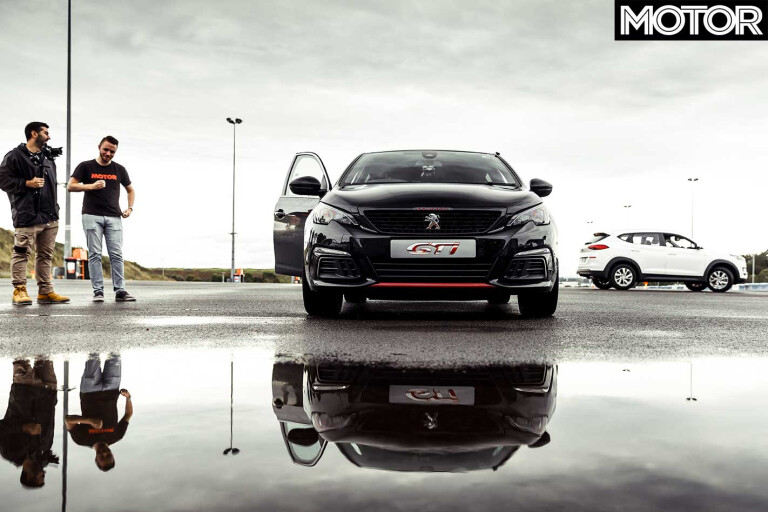
Sydney Dragway, 7.30am. It’s 17 degrees Celsius, damp, and incredibly foggy, but it’s not raining. Score.
Some of the various crews involved in making our tyre test run smoothly have already arrived, including the team from JAX Tyres, as the MOTOR hire car rolls into one of the large car parks near Sydney Dragway. That car park soon becomes scattered with cones and turns into a small motorkhana course (we’ll explain later), while the surface is still damp from the previous cold, drizzly night.
Not far away is another area set aside for wet testing, sprinklers are at the ready to keep the surface saturated. Finally, a couple of hundred metres away is the prepared surface of the drag strip, with cones arranged for a slalom and dry brake test. If it were viable for us to do our tyre test indoors, we would. But Sydney Dragway is the next best thing.
2019 Peugeot 308 GTi: The Car
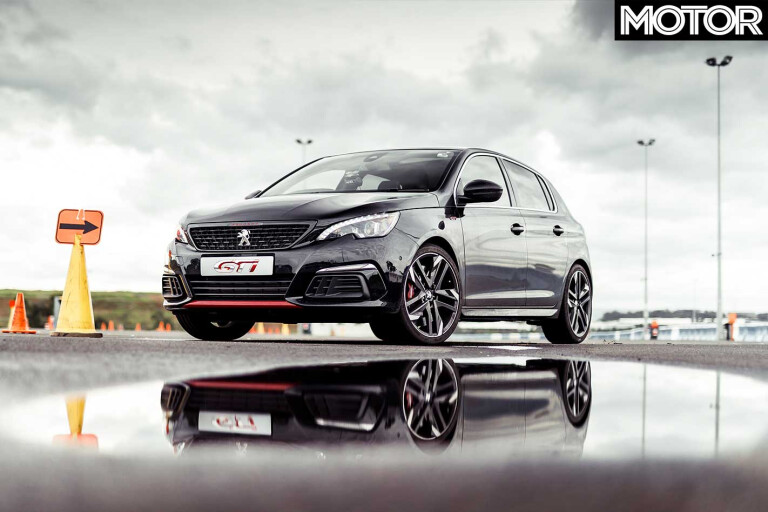
Graciously supplied by France’s own ‘lion brand’, a Peugeot 308 GTi serves as the test car for this year’s big event. Wearing the control tyres upon arrival, the GTi is joined by a backup car which primarily exists to lend its wheels to make the job faster and easier for the pit crew. An extra set of wheels means another set of tyres can be ready before the car comes back in to swap over.
With 200kW and 330Nm, a six-speed manual gearbox, and a 1205kg kerb weight, the GTi proves to be an exciting enough car to watch (and photograph), with its playful chassis providing plenty of opportunities for Luffy to cock a wheel. His only complaint about the car was that it didn’t have a racing seat, but a seat designed for comfort. It turns out MOTOR’s Tyre Test requires a well-bolstered seat.
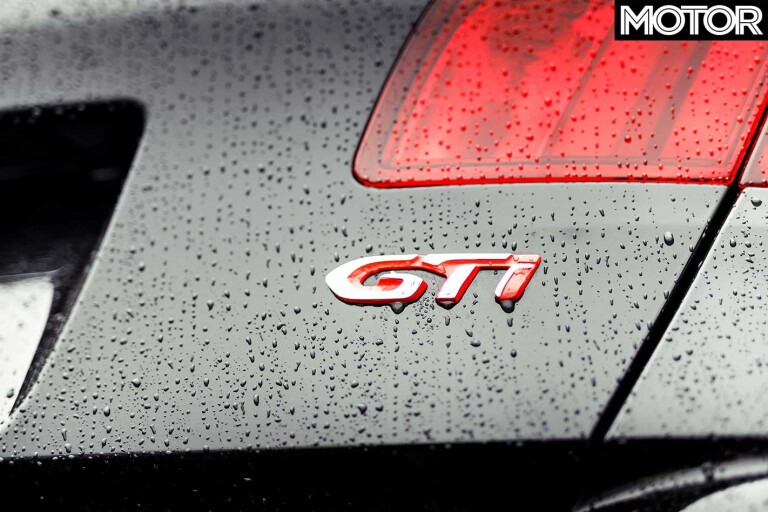
The 308 GTi firmly ticks all other boxes though, those being some serious braking hardware (monster 380mm front discs and four-piston Alcon calipers; 268mm, single-piston rear), essential for repeatability; ESP that can be fully deactivated; a front limited-slip differential; and slightly stiff suspension offering some very tight body control. We’ve driven the 308 GTi on track at several other MOTOR tests and came away impressed with its ‘trackability’ and longevity.
That its 19 by 9.0-inch wheels are shod with stock 235/35 ZR19 tyres – a very common fitment these days – also helped. The OE tyres are Michelin Pilot Super Sports.
MOTOR Tyre Test 2019: The Tyres
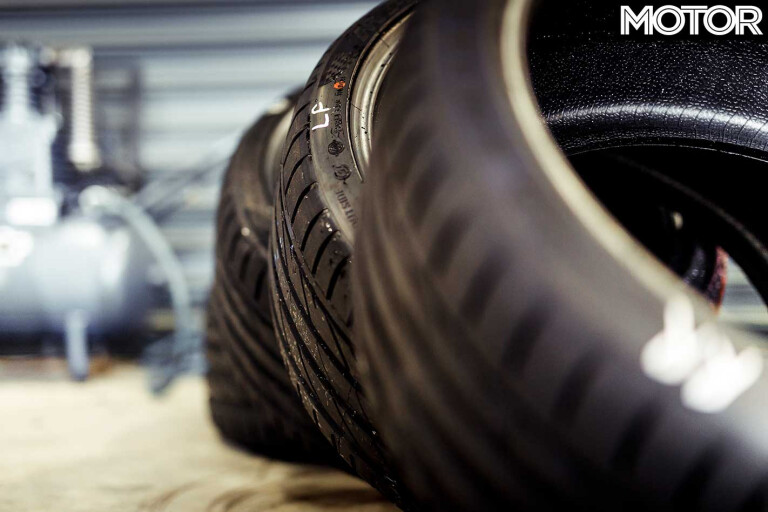
It's shaping up as a battle between four heavyweights, one brand wanting to play with the big boys, and two budget options testing their mettle at the same time.
While the big news is the appearance of the new Michelin Pilot Sport 4S after its very notable absence last year, it has to face the reigning champion, the excellent Continental SportContact 6. The hot new Bridgestone Potenza S007A will be trying to cause an upset; while the sizzling Goodyear Eagle F1 Supersports has been included for our test, too. The venerable Pirelli P-Zero, ever the dark horse, is entered into this ring as well.
All these brands have, at some or numerous points in this shootout’s 17-year history, won the MOTOR Tyre Test before. With a price not too far off the aforementioned group, the Maxxis Victra Sport 5 wants to be taken seriously.
Meanwhile those curious about a cheaper set of rubber can keep an eye on affordable patterns in the form of the HiFly HF805 Challenge DSRT and Infinity Ecomax. Brands like Dunlop, Hankook, Toyo and Yokohama are the notable absentees this year. It’s important to note it’s risky business giving tyres over for an independent test like this, so credit to those who did.
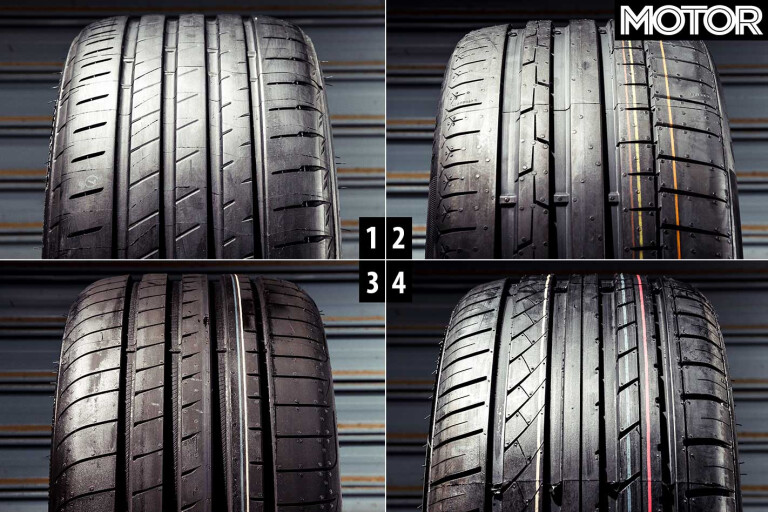
01 - Bridgestone Potenza S007A
Origin: Japan
Treadwear Rating: 240
Load & Speed Rating: 91Y
02 - Continental SportContact 6
Origin: Czech Republic
Treadwear Rating: 240
Load & Speed Rating: 91Y
03 - Goodyear Eagle F1 Supersport
Origin: Germany
Treadwear Rating: 240
Load & Speed Rating: 91Y
04 - HiFly HF805 Challenger DSRT
Origin: China
Treadwear Rating: 280
Load & Speed Rating: 91W

05 - Infinity Ecomax
Origin: China
Treadwear Rating: 280
Load & Speed Rating: 91Y
06 - Maxxis Victra Sport 5
Origin: China
Treadwear Rating: 320
Load & Speed Rating: 91Y
07 - Michelin Pilot Sport 4S
Origin: France
Treadwear Rating: 300
Load & Speed Rating: 91Y
08 - Pirelli P Zero
Origin: Italy
Treadwear Rating: 220
Load & Speed Rating: 91Y
The MOTOR Tyre Testing Process
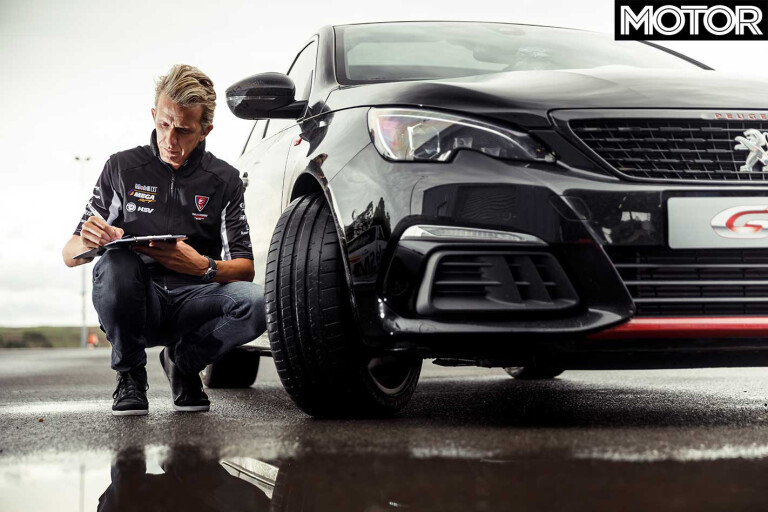
This is where the fun starts. The course cones are set up, the majority of the tyres have arrived and are accounted for, the JAX Tyres crew sorts out a temporary workspace, and our gun driver Warren Luff is comfortable in the 308 GTi. The day can kick off.
Tyre pressures are checked at 35psi cold, according to the Pug’s tyre placard. Once the fog clears, 8:25am marks the first run, setting times with the control tyre across the five exercises and, theoretically, setting the data point for what will be the most disadvantaged runs of the day due to a still-damp surface and an ambient temp of 19 degrees, still rising.
The first four tyres on the competitor list make their runs, with the JAX team using a second set of the same wheels to get a new set ready while Luffy runs each tyre through the five exercises. After the first half, another control run is set to see how variables such as surface moisture and brake wear might be affecting the tyres’ results.
The second half of the pack undergoes its runs and then the last control run sets the endpoint for variable adjustment, which we later use an equation to work out. More on that later.
Warren Luff: The Driver
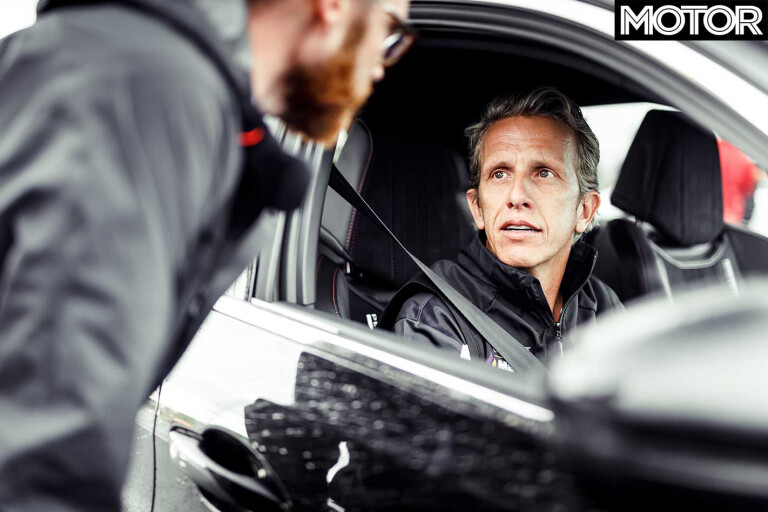
Tyre testing is all about controlling the variables, and this one we’re very confident has things under control – Warren Luff. Our go-to tyre tester for more than 10 years now, Luff is also the go-to man for the nation’s top motorsport outfits.
A two-time winner of the Sandown 500 (2012 and 2016), Luff is back in the enduro role for Walkinshaw Andretti United in 2019 where he will chase down that elusive Bathurst 1000 win (having finished on the podium more times than he’d like to be reminded). When he’s not also racing in Carrera Cup or coaching drivers, Luff is tearing about Movie World at his ‘day job’ running the stunt show.
What separates a professional driver from a very good amateur is the ability to consistently extract the absolute maximum from the car, and tyre – no matter the course, demands or conditions – and Luffy is a perfect example of this. Frankly, with his experience of road-based performance tyres, and road-going new performance vehicles, we wouldn’t have any other driver behind the wheel.
Racelogic VBOX: The Equipment
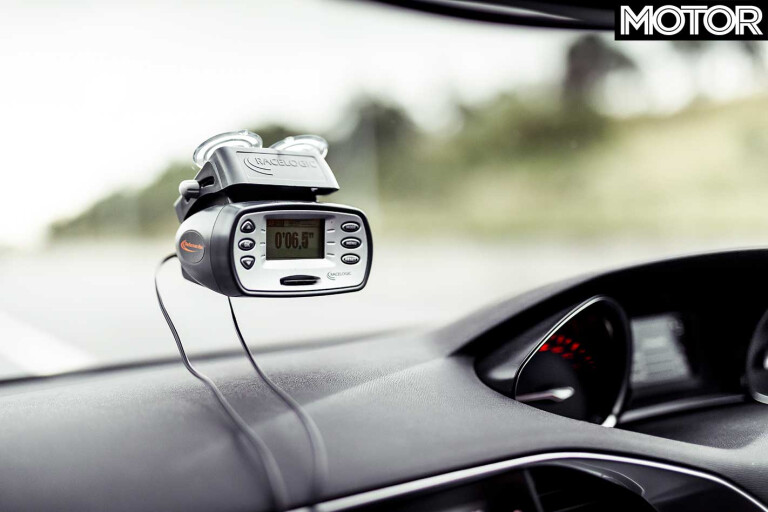
All competition runs are recorded with Racelogic VBOX GPS timing hardware and later closely verified against secondary data collected on the day. We’ve used Racelogic equipment for our Tyre Test for years, as well as all our other major tests where accuracy and reliability of data is paramount, and swear by it.
The Maths Explained

To make sure that the running order of our tyre test doesn’t advantage the tyres running in the drier or warmer weather conditions, or those that run while the car is in its fittest shape, we apply a linear regression formula to our control tyre runs to find out how external factors could affect the results.
For example, if the control tyres run faster as the day goes on, it means the last competitor tyre has an advantage. The linear regression formula essentially applies a handicap to each tyre based on how the control tyre would run at that time. This creates results based on each tyre running in the same conditions, and leaves little room for ‘what if this tyre ran first?’ scenarios.
Controlling The Variables
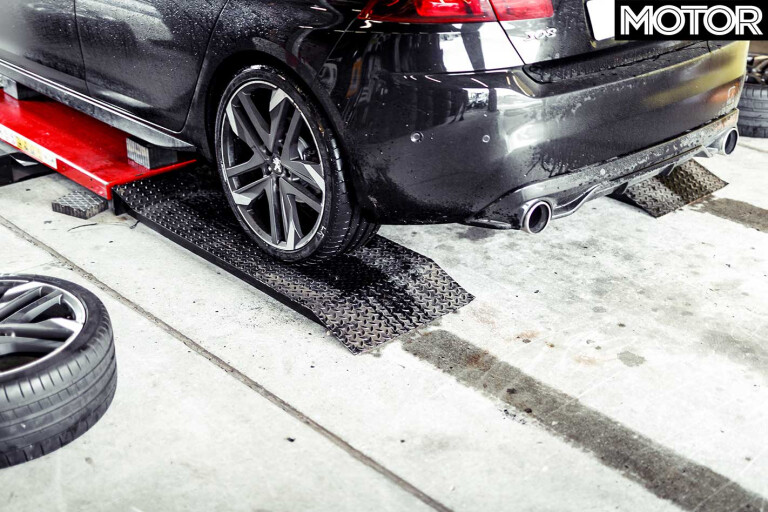
As stated earlier, this test is as accurate as it can be, but these results are still prone to factors out of our command. The control tyre and linear regression formula are the best defence against data anomalies like weather and vehicle fatigue, but there are still a few other elements to consider.
For example, it’s difficult to keep the wet testing surface at the exact same level of saturation for the entire day, but the trend of raw results indicates that the sun’s decision to appear in the late morning and warm the surface up was the biggest impact on wet brake testing performance.
Finally, Luffy is still a human. It’d be near impossible to find anyone more suited to the job given his experience and ability to nail run times down to the tenth repeatedly, but nobody’s entirely perfect. Not even Luffy... just don’t tell him we said that.
JAX Tyres: The Pit Crew

It turns out tyres make an incredibly loud ‘pop’ sound when they’re seated onto a wheel. Anyone who had never been present at a MOTOR Tyre Test or a tyre workshop wouldn’t know how loud it is, but the JAX Tyres team is so used to it they don’t even flinch anymore.
We can’t say the same for the rest of us. Not only do loud noises not scare them, but the JAX crew is made up of professionals who know their stuff, and made 44 wheel changes look like an absolute breeze. We owe them a big thanks for their help at Tyre Tests over the past couple of decades. To make the process even smoother, JAX was joined by Eagle SMF with tyre-changing equipment on hand.
Make sure you head over to jaxtyres.com.au or give them a bell on 1300 367 897 next time you’re after a set of shoes for your ride.
The Five Test Disciplines
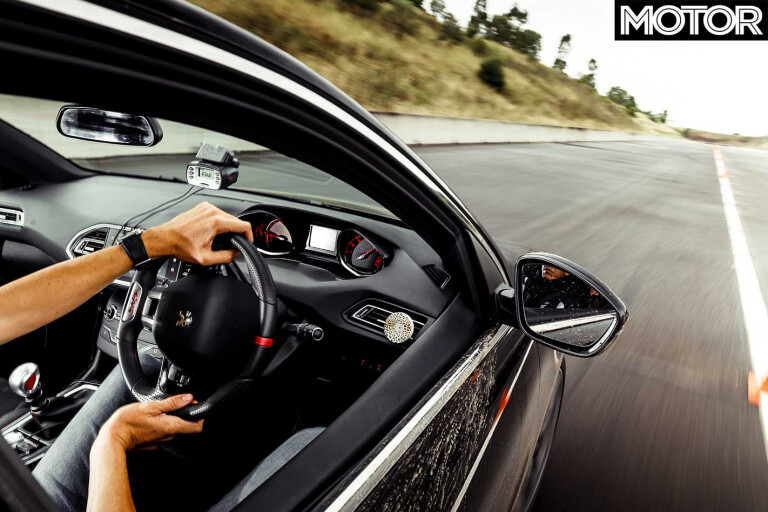
All of our exercises are completed in the same order for each tyre, with the car’s electronic assistance off, its drive settings set to Sport mode, and as per Luff’s personal comfort requirements, the air-conditioning set to 18 degrees Celsius.
In the interest of transparency, the running order of the tyres is as follows: control, Goodyear, Pirelli, HiFly, Michelin, control, Maxxis, Infinity, Bridgestone, Continental, and then a final control run.
The tests are completed in the same order each time, so by the time each tyre has reached the wet lateral G test, it’s already been through the wars.
It should be noted that our reason for not including a dry lateral G score is that the data tends to spike, and can’t be read accurately without the risk of including anomalies.
Dry Slalom
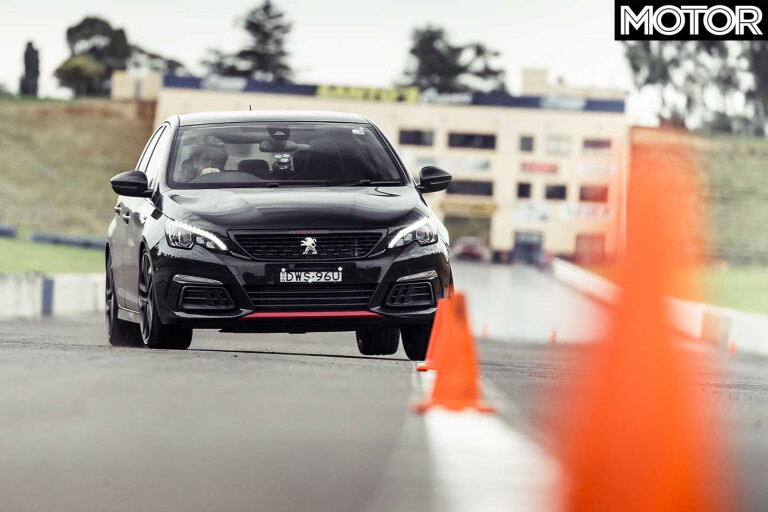
The first test each tyre must conquer is the dry slalom, a fairly self-explanatory line of cones which Luffy approaches at 60km/h before weaving through each ‘gate’ to the end of the line. This is done five times, with the best and worst times from beginning to the slalom’s end being disregarded to avoid including outliers in the final results. The middle three results are then averaged.
Despite Sydney Dragway’s grippy surface, the early morning moisture sticks around long enough to noticeably affect the earlier tyres’ times in the running order. The first control runs averaged out to 10.7sec for Luffy to traverse the slalom, while the second set worked out to a 10.43, and the last to 10.37.
Although the Bridgestones set the fastest time on the day, they also had the advantage of running late in the day when the surface was warmer and drier. After running the data through our formula, the Michelins come out on top after tying for second with the Continentals in our raw data. The Continentals ran last, with the best weather conditions, so they cop a penalty from our formula and land mid-pack.
HiFly and Infinity produced times about a half-second slower than the next-best tyre, the Maxxis Victra, even after linear regression is applied. It’s not a terrible result, but there’s a clear split.
Dry Braking

Conducted after the first, third, and fifth slalom runs to give the brakes a chance to cool, the dry braking test consists of a gate approach at 115km/h to ensure the VBOX only records consistent deceleration from 100km/h to 0km/h. The three distances recorded, down to the centimetre, are averaged to provide the score for each tyre.
The control runs for this test showed that the later runs were actually the runs with the disadvantage, as the increasingly hot surface on the strip and slowly wearing brakes led to a decline in the ability for the GTi to pull up.
The Continentals put in a valiant effort, just missing out on the podium for this exercise in our raw data. Since they ran last, however, it was the adverse testing environment that initially stole the win away. Luckily for the Contis, our linear regression formula sets the record straight.
Dry Motorkhana
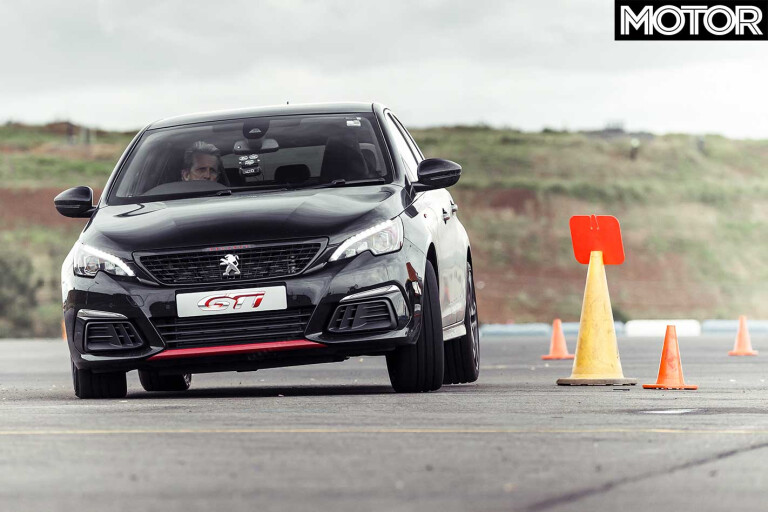
The “road course” is a small track laid out with cones to incorporate as many varied corners as possible, with a couple of places for different braking and acceleration techniques to be used. It’s not Phillip Island but it’s laid out such to test the lateral ability of the tyres in very slow and medium-speed corners. Three laps of the course are hand-timed, with the total of three laps providing a total time. These times are later verified against VBOX data.
Between the big brands this year, it came down to tenths, rather than seconds, to decide the winner. The times recorded on the day put the Michelins ahead by almost three tenths, with the Continentals in second and the Bridgestones just two hundredths shy of that.
The mid-pack was all within a single tenth, with the Infinity and HiFly around three whole seconds slower to bring up the rear. After the linear regression was applied, the Michelins kept the top rung, but the Continentals running last put the German brand at an advantage on the day, so the maths wasn’t on its side later on.
Wet Braking

Like dry braking, but with water. On a different surface, away from the strip, the sprinklers keep a section of tarmac wet for Luffy to approach in the GTi at just above 85km/h to ensure the VBOX provides a clear 80-0km/h figure. As with the dry test, three runs are averaged to provide a representative result.
We were dealt a rather hefty shock when we started compiling the wet testing data, particularly the braking. In recent years, Continental’s entry into our tyre test has dominated wet performance. The SportContact 6 won last year due to this, while also maintaining decent performance in other tests.
This year, we find Maxxis on top, even in the raw data. We had the same result during Tyre Test ‘Attempt One’ about a month prior and dismissed it as inclement weather affecting data. It turns out, we were wrong. The Victra Sport 5 is excellent when it comes to wet braking.
Interestingly, the first control run ended with a stopping average of approximately 3.5 metres longer than the other, later two, which both averaged 26.4m. This could mean all the tyres that ran in the second half, and potentially even some from the first half, had roughly similar chances of performing at their best.
Wet Lateral G
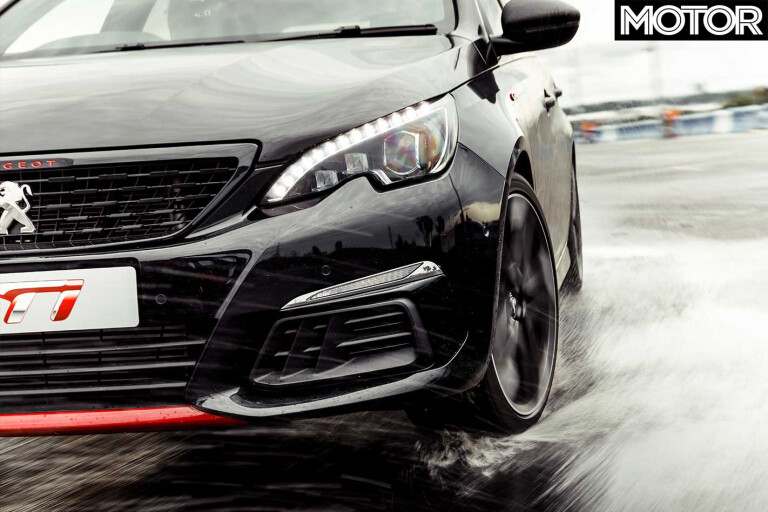
On a small, wet, oval course, Luffy approaches a corner at 40km/h in second gear, and performs a 180 degree turn, before turning around and doing the same thing in the other direction. Three right, and three left turns with consistent steering and smooth throttle to avoid inducing a false G-force peak. We use the raw information, and remove the two outliers (highest and lowest reading) before averaging the rest.
While 1G is a significant force, its actual numerical value is low, and most tyres’ average maximums were within 0.1G of each other. Even tighter were the top four, in the raw data the top quartet (Potenza, SportContact 6, Eagle F1, and Pilot Sport respectively) were all within a 0.00375G range. The advantage afforded to tyres that ran later in the day resulted in what you see in the final table, thanks to the linear regression formula.
MOTOR Tyre Test 2019: Summary
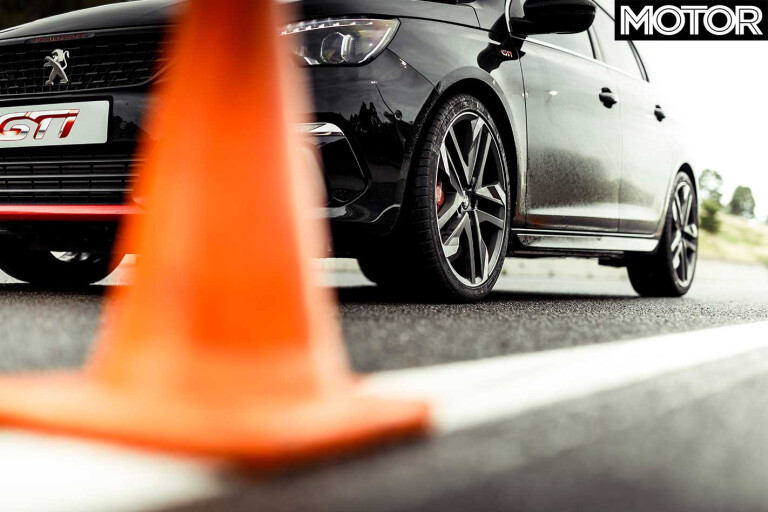
The winner of each exercise is awarded a score of ‘1’, down to ‘8’ for the last place-getter. As is clear in the case of the Michelins, consistently placing on the podium is almost guaranteed to secure a win, and that’s why the Pilot Sport 4S is this year’s Tyre Test champ. Excellent cornering in the dry, the ability to overcome wet surfaces, and the ability to pull up quickly has earned it the top spot.
Goodyear’s very new tyre came close to a win before it even made it to market, but second place in a test like this is proof the F1 Supersport is a top-notch bit of rubber.
The mid-pack is where the real tension is, however, with four excellent tyres almost equalling for third place. The Victra’s superior braking ability was its only standout, but it was enough to equal the Potenza on the podium. The lack of a podium spot should absolutely not rule out Pirelli and Continental from your shopping list.
Continental’s superior wet performance won it the gong last year. It seems the opposition has caught up, and that can only be good when you’re shopping for rubber.
MOTOR Tyre Test 2019 Results
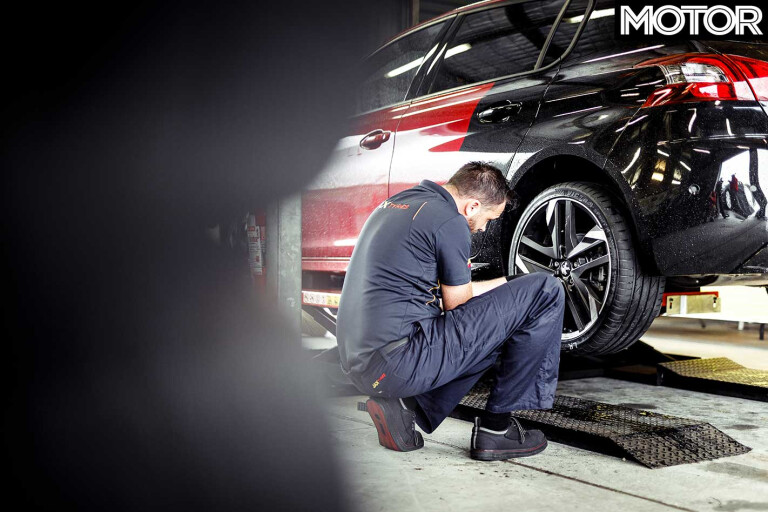
| Ranking | Tyre | Slalom | Dry Braking | Motorkhana | Wet Braking | Wet Lateral G | Total Score | Price* |
| 01 | Michelin Pilot Sport 4S | 1 | 3 | 1 | 2 | 2 | 9 | $345 |
| 02 | Goodyear Eagle F1 Supersport | 2 | 6 | 2 | 3 | 1 | 14 | $389 |
| =03 | Bridgestone Potenza S007A | 4 | 2 | 5 | 6 | 3 | 20 | $389 |
| =03 | Maxxis Victra Sport 5 | 6 | 4 | 4 | 1 | 5 | 20 | $345 |
| =05 | Continental SportContact 6 | 5 | 1 | 6 | 5 | 4 | 21 | $345 |
| =05 | Pirelli P Zero | 3 | 5 | 3 | 4 | 6 | 21 | $365 |
| 07 | Hifly HF805 Challenger DSRT | 7 | 7 | 7 | 7 | 8 | 36 | $149 |
| 08 | Infinity Ecomax | 8 | 8 | 8 | 8 | 7 | 39 | $140 |
*Prices listed are a guide only. Contact your local dealer. Prices are correct as of June 2019
MOTOR Tyre Test 2019: The Numbers
Michelin Pilot Sport 4S review: Winner
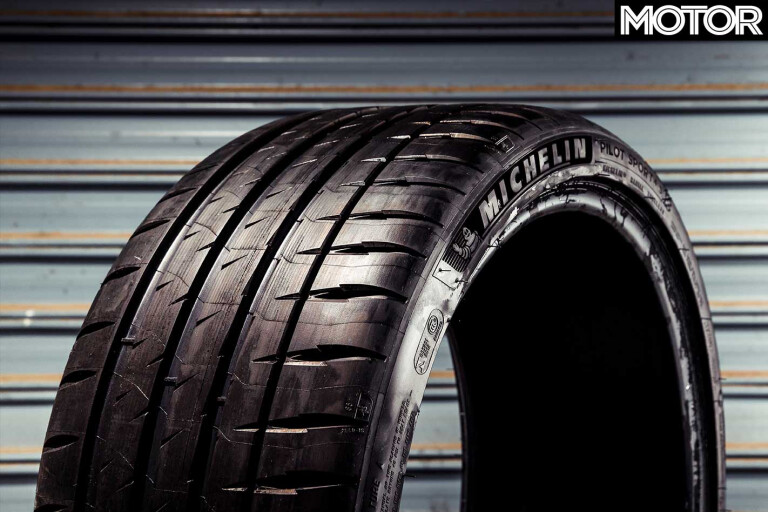
Origin: France
Treadwear Rating: 300
Load & Speed Rating: 91Y
Slalom results: 10.2sec (1st)
Dry braking: 34.93m (3rd)
Motorkhana: 76.97sec (1st)
Wet Braking: 23.95m (2nd)
Wet Lateral G: 1.0184G (2nd)
Goodyear Eagle F1 Supersport review: 2nd Place
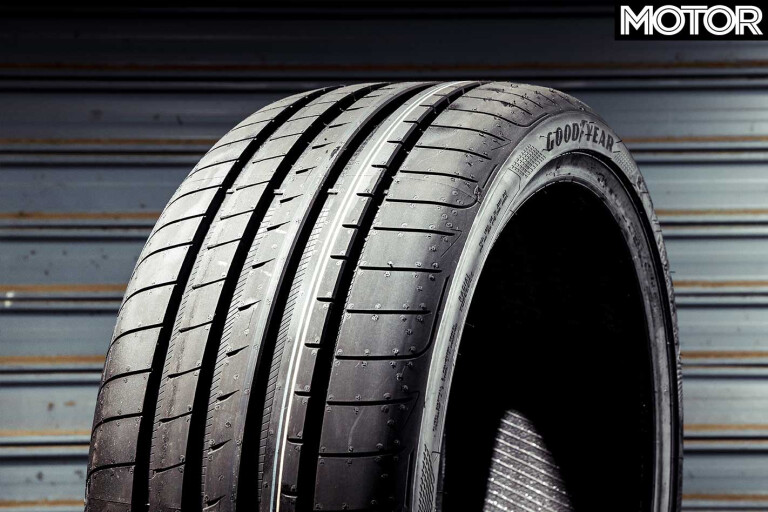
Origin: Germany
Treadwear Rating: 240
Load & Speed Rating: 91Y
Slalom results: 10.25sec (2nd)
Dry braking: 36.43m (6th)
Motorkhana: 77.25sec (2nd)
Wet Braking: 24.16m (3rd)
Wet Lateral G: 1.0221G (1st)
Bridgestone Potenza S007A review: Joint 3rd Place
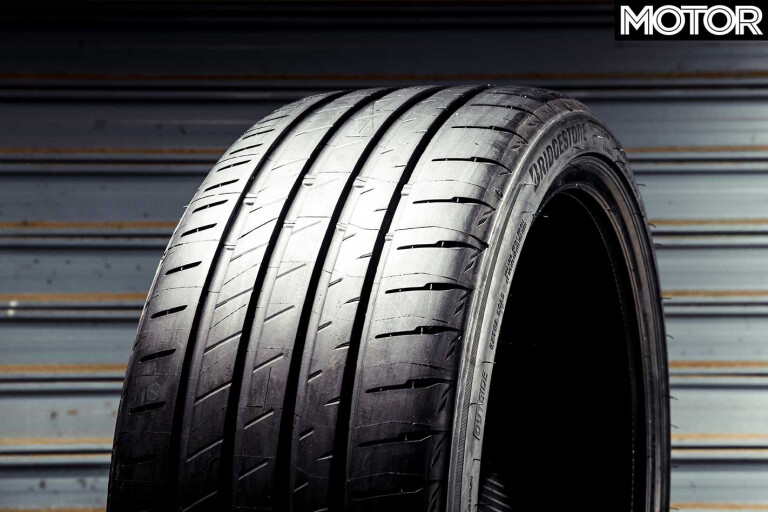
Origin: Japan
Treadwear Rating: 240
Load & Speed Rating: 91Y
Slalom results: 10.31sec (4th)
Dry braking: 34.14m (2nd)
Motorkhana: 77.91sec (4th)
Wet Braking: 24.96m (6th)
Wet Lateral G: 1.0175G (3rd)
Maxxis Victra Sport 5 review: Joint 3rd Place
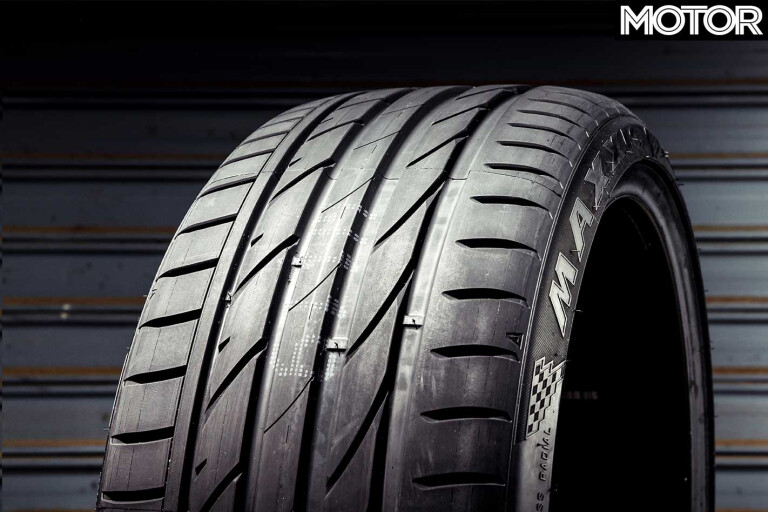
Origin: China
Treadwear Rating: 320
Load & Speed Rating: 91Y
Slalom results: 10.45sec (6th)
Dry braking: 35.45m (4th)
Motorkhana: 78.05sec (6th)
Wet Braking: 23.79m (1st)
Wet Lateral G: 1.0111G (5th)
Continental SportContact 6 review: Joint 5th Place

Origin: Czech Republic
Treadwear Rating: 240
Load & Speed Rating: 91Y
Slalom results: 10.37sec (5th)
Dry braking: 33.98m (1st)
Motorkhana: 77.93sec (5th)
Wet Braking: 24.46m (5th)
Wet Lateral G: 1.0151G (4th)
Pirelli P Zero review: Joint 5th Place

Origin: Italy
Treadwear Rating: 220
Load & Speed Rating: 91Y
Slalom results: 10.28sec (3rd)
Dry braking: 35.87m (5th)
Motorkhana: 77.50sec (3rd)
Wet Braking: 24.42m (4th)
Wet Lateral G: 1.004G (6th)
HiFly HF805 Challenger DSRT review: 7th Place
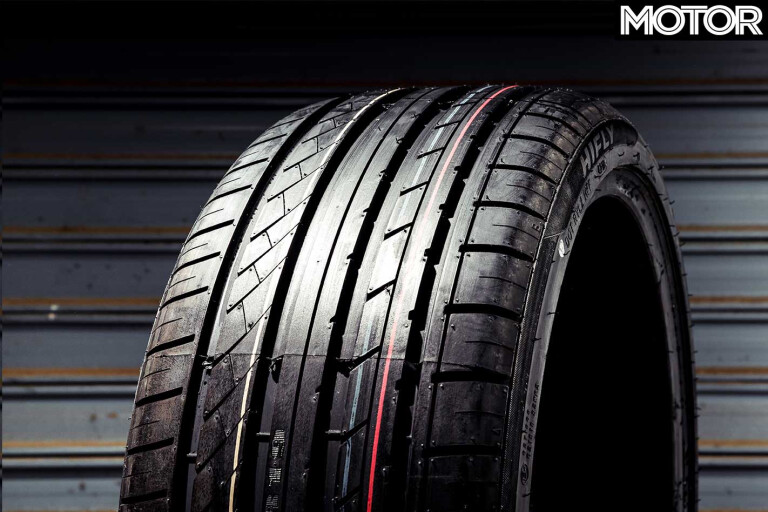
Origin: China
Treadwear Rating: 280
Load & Speed Rating: 91W
Slalom results: 11.02sec (7th)
Dry braking: 38.66m (7th)
Motorkhana: 80.68sec (7th)
Wet Braking: 27.35m (7th)
Wet Lateral G: 0.904G (8th)
Infinity Ecomax review: 8th Place
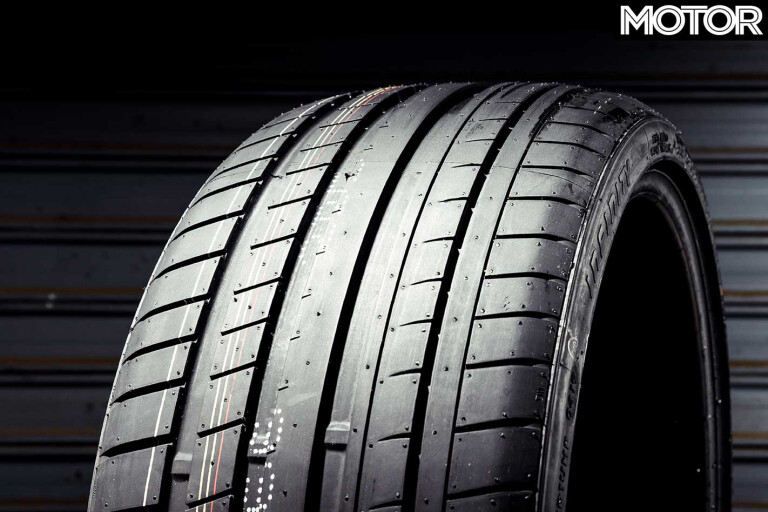
Origin: China
Treadwear Rating: 280
Load & Speed Rating: 91Y
Slalom results: 11.04sec (8th)
Dry braking: 39.27m (8th)
Motorkhana: 81.07sec (8th)
Wet Braking: 27.86m (8th)
Wet Lateral G: 0.936G (7th)

COMMENTS